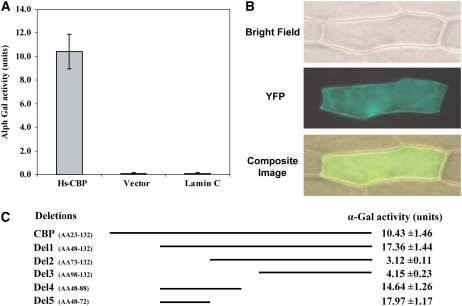Figure 2.
Hs CBP Reproducibly Interacts with PME3.
(A) α-Gal quantitative assays of the CBP/PME3 interaction. Yeast strain AH109 was cotransformed with the prey plasmid in combination with either the CBP bait vector, pGBKT7-lam (expressing lamin C as a GAL-4 DNA-BD fusion), or the empty pGBKT7 bait vector and plated on SD/-Leu/-Trp. Three days after culture, 10 separate colonies per combination were picked to quantify the interaction using α-Gal activity. Activity was seen only in yeast cells containing the PME3 prey plasmid and the CBP bait vector. The experiment was repeated four times with identical results.
(B) BiFC visualization of the CBP/PME3 interaction. Onion epidermal cells were cobombarded with constructs expressing the nEYFP-CBP and cEYFP-PME3 and bright-field, YFP and overlay of bright field, and YFP images were taken 20 h after bombardment.
(C) Mapping the CBP domain involved in the interaction with PME3. Yeast strain AH109 cotransformed with prey plasmid and the different bait constructs indicated in the scheme were streaked on SD/-Leu/-Trp, and 3 d after culture, 10 separate colonies per construct were picked to quantify α-galactosidase activity. The assays were repeated three times with identical results.

